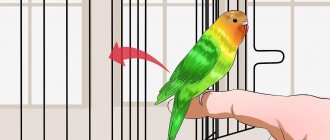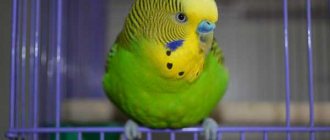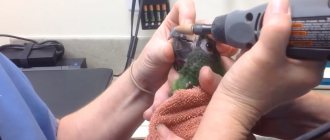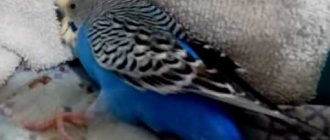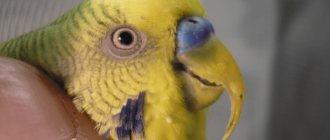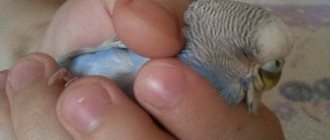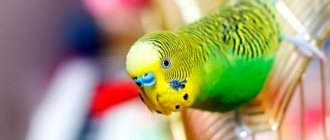Many owners are faced with the fact that their parrot is afraid of hands, toys, new food and other things. Here is a way to solve this problem. In all situations, the approach will be the same - to find the root cause of fear and, depending on the cause, eliminate it or demonstrate to the pet that this object or event is safe for it.
Our feathered friends can indeed be afraid of various things and actions that, in the opinion of a person, not only should not be perceived negatively by the bird, but also bring pleasure to the feathered friend. It is up to the owner of the parrot to understand the nature of the pet’s fear and do everything possible to make the bird feel safe.
What are parrots afraid of?
- owner's hands;
- bathing;
- new toys;
- other parrots and other domestic animals;
- strangers;
- darkness;
- loud, harsh noise;
- new food;
- new cell.
Any phobia is based on some reason, instinctive or associated with some negative event. The parrot is afraid of hands because sitting on a person's hand is not a natural behavior for him, or maybe the reason is that this parrot was caught with his hands when he was happily living in his wild nature. In any case, the bird owner needs to listen to the body language of his pet and analyze his behavior. Recognizing the cause of fear is the first step to successfully combating a phobia.
How to behave
So, when the first days after stress are already behind you, you can begin to accustom your parrot to yourself. You can stay near the parrot's cage more often and longer while the pet is walking. If you don’t make sudden movements or make noise, you will seem less scary to the parrot, and therefore start the process of habituation. And again, you should not expect instant results; you will have to show patience and achieve results after some time.
Find out more about keeping such parrots as: lovebirds, Corella, Jaco, kakapo, macaw, rosella, as well as Amazonian and necklace parrots
The next step in how to tame a budgie will be to gradually increase your exposure inside the parrot's cage. Of course, you yourself won’t fit into it, but putting your hand inside and standing there for a minute, then more and more, will literally help you tame the bird. After some time, your ward will get used to your hand and will no longer be afraid of it. Then the parrot will be more willing to approach your hand and will even be able to become tame and stay in your hands for a long time.
To consolidate the achieved reconciliation, you should encourage your little pet and treat him with his favorite food. This way he will remember that the presence of your hand and you in his domain will lead to the appearance of tasty things in the feeder, and this will appease him even more. By repeating this procedure every day for a week or two, you will tame your feathered pet and will be able to hold it in your arms more often and continue to communicate with it.
After your friendship begins, you can play with the parrot. For example, tickle his tummy or offer him a game of ball, which these birds willingly play. Hand him a ping pong ball and he'll start kicking it around the cage.
Did you know? An original way to play together with a parrot
—
collect simple figures from Lego.
You assemble, and your little friend takes it apart and does it with great pleasure and interest. Try it! In addition, you should start training him so that he can sit on your finger. To do this, place your finger under his chest, so that it is convenient for him to climb onto it with his paws. Even if not right away, the little pupil will do what you want from him. These exercises will also help in the process of taming your parrot and establishing a close bond with it.
Now let's look at the basic rules for caring for budgies and the basics that every owner of this bird should know. They can be reduced to the following list:
Cell:
- should be large enough for the parrot to feel comfortable in it;
- the cage should be located away from computers, televisions and other household appliances;
- Direct sunlight should not fall on the cage, but the place where it is located should not be too dark either;
- the cage should not be placed on window sills, as there is a possibility of draft;
- Do not place the cage near heating appliances.
Did you know? In Australia, special schools have been created for these birds.
In them, parrots are taught to talk if the owners do not have the opportunity or desire to do it themselves.
Room where the cage will be located:
- should be spacious;
- there should be no sharp or dangerous objects in it;
- during walks, you need to keep an eye on your pet so that it doesn’t get stuck somewhere and cause damage (for example, it’s better to remove vases or figurines, since not only can they get hurt, but the bird can also be injured by fragments);
- The windows in the room should be closed, and if it is summer, then you cannot leave the windows without mosquito nets and you cannot create a draft.
Care:
- regularly let the bird go for a walk (once or twice a day);
- change food as needed, do not be overzealous with its quantity;
- replace water once or twice a day;
- Wash the feeder and drinking bowl thoroughly with warm water and wipe dry;
- do not forget to play with your pet, spend time with him every day;
- During molting, support the parrot's body with special vitamin complexes.
And although these are not all the recommendations for caring for birds, these are the basic, basic rules that must be followed strictly so that your pupil is comfortable and happy in your home.
Now let's talk about how to play with a budgie. The main toy for him, which is also very useful for hygienic needs, is a small, up to 20 cm, branch of fruit trees. Such a branch must be under the parrot’s paws inside the cage. You can also tie several dozen of these branches into an improvised bundle of brushwood. Your pet will also like this option.
Also kept at home are birds such as canaries, crossbills, siskins, and ravens.
Other options could be either special toys in pet stores or regular household utensils. Toys of natural origin will also be useful, for example, fir cones, twigs, pineapple leaves. Parrots also enjoy success with all kinds of ladders, cubes, pyramids, rings and balls. But remember, no toys can replace a parrot’s live communication with its owner. Therefore, do not forget to give your pet time and attention.
Two steps to eliminate fear
- All of the above and other fears are justified and natural. But owners can give their parrot a sense of security and calm by gradually training their feathered friend. It is important to understand why the parrot is afraid! Watching a bird and understanding the causes of phobias can radically change the situation in a positive direction. First of all, you need to get the bird to trust you. For some birds this is a fairly slow process. And the owner needs patience and time to let his pet get comfortable.
- The best way to combat the fear of new things is through positive reinforcement. The essence of positive reinforcement is that the owner of the bird reinforces the positive emotions of the pet during any correct action by praise, favorite things or treats for the birds.
Hand Taming
How to tame a budgie? First you need to remember a few simple rules. Accustoming a budgerigar or any other parrot to being handled requires the following:
- Taking into account the age and gender characteristics of birds. A boy learns a little differently than a girl.
- Thoughtful and correct actions.
- Regular classes. If they are carried out irregularly, from time to time, then you may not expect a normal result.
After the bird is no longer afraid of the human voice, you can move on to the next stage of training. You need to open the cage door with smooth movements and stick your hand in, each time getting closer to the bird. At first she will worry and scream, but this is an absolutely normal reaction to danger. You cannot touch or pet the bird yet, otherwise the whole process will have to be repeated all over again.
Read also: How to build a school in The Sims 4?
It is important to remember that when training, shouting, sharp waving of arms, and punishment of the parrot are unacceptable. This will only prevent you from making friends with the bird.
Example of actions for fear of toys
For example, a parrot is afraid of a new toy or any toys in general. What to do in such a situation? First, show him that this item is safe for you, that is, you yourself enthusiastically play with this toy, rejoice and show positive emotions. The winged pet, being very curious by nature, will want to join your fun after a while.
Reward your pet generously for the slightest attempt to come closer to the toy or touch it. Use treats or just strong emotional praise as a reward. Do not force or force your bird to make contact with the toy if it does not want to. She must want to approach the new object herself.
Bird training should be slow and gradual; you should not try to speed up the process. If your pet begins to touch the toy, this does not mean that it is time to hang it in the cage. For him, this is a still unknown thing that poses a danger to him. Speeding up the process can lead to the opposite result and all your efforts and time spent getting to know a new subject will be wasted. Another example, a feathered pet is afraid of water procedures. Proceed in this situation in the same way - put his favorite things, if any, or treats in the parrot’s bathing suit. Encourage any attempt to approach the bathing suit from the bottom of your heart. And over time, bathing can turn into a favorite pastime.
Love, patience and gradual learning pay huge dividends. By gaining the trust of your pet, you can make the life of your feathered pet happy and safe.
How to teach a budgie to sit on your hand and dance
The next step in communicating with your bird will be teaching him various tricks and funny dances. It is important to consider that such training is carried out only if the pet is quietly outside the cage for a long time. Otherwise, the bird may become frightened by sudden movements of the owner and stop flying into the hands.
The parrot should calmly react to human movements. You need to carefully move your hand, walk around the room with the sitting bird, and talk to it kindly. When it stops flying away, you can turn on the music.
Often parrots independently react to rhythmic music by moving their heads funny. Then daily training will help you consolidate the results.
A non-musical pet will need help. When you turn on any melody, you should move your hand in different directions and shake it to the rhythm of the music. If you start dancing with your head while doing this, the parrot will quickly learn the exercise and begin to imitate its owner.
Associated symptoms
Fright in a budgie may be accompanied by the following symptoms:
- behavior changes, if previously the bird was active and cheerful, now aggression and erratic movement around the cage are clearly noticeable;
- refusal to fly freely, the state of stress does not allow the bird to take its usual walk, it constantly sits in the corner;
- unkempt appearance, indifference to the surrounding environment;
- wild scream, throwing around the cage, sharp flapping of wings;
- refusal to eat, fear is manifested by a decrease in appetite;
- the bird can make a mess in the cage, turn over the feeders, drinkers, scatter the offered treats, thus demonstratively destructive behavior is diagnosed;
- nervousness and fear of familiar objects;
- aggressive behavior in relation to the owner;
- independent plucking of feathers from the body.
Numerous symptoms accompany a violation of the psycho-emotional state. To restore normal well-being, it is necessary to carry out treatment from the first days.
Comfortable conditions
Before buying a parrot, think through all aspects of the pet’s comfortable living conditions, read the recommendations of experts, chat on forums and among your friends with those who have parrots. When purchasing the necessary attributes, pay attention to the materials from which they are made.
The cage should be spacious so that the parrot can move freely around it, spread its wings and wave them, jump from perch to ladder, and play with toys. The feeder usually comes with the cage. It is better to choose a ceramic or porcelain drinker rather than plastic. It costs more, but in such dishes harmful microflora develops more slowly, and the water stays clean longer. Choose toys made from environmentally friendly materials with high-quality coating.
Decide where to place the cage. At first, it should stand higher - approximately at the height of a person, preferably next to a wall. This way the bird feels more protected. You can place the cage on pieces of furniture that are suitable in height - a closet, a cabinet, a pencil case. There should be no indoor plants near the cage - many of them are toxic to parrots.
In comfortable conditions, the bird will more easily bear the stress of moving to a new home.
Taming
The best option for a beginner in communicating with parrots is to buy a young parrot, which is much easier to make contact with a new person and can more easily tolerate a change of environment. All the stages of rapprochement described above will be easier for a young bird than if you began to tame an adult. So, the best way to get to know a young budgie is to talk, but only from afar. Your pupil will definitely become interested in you and will take a long and careful look at the new object, which also makes sounds. Another way to please this temperamental bird is to identify its favorite treat. But don't spoil her too much.
For example, if your bird is trainable and does what you ask of it, thank it by hand-feeding it its favorite treat. Let the young parrot get used to the fact that he only gets tasty things from your hands. First, push the treat through the bars of the grill, and after a while do this through the open door. Without the rods the level of trust will be much higher and the parrot understands this too. The next step is to offer this delicacy outside the cage, during a walk. For example, when a bird sat on your finger or actively played.
It will be more difficult to find a common language with an adult parrot. But it is more difficult in terms of time, because a mature bird tolerates a change of environment and new living conditions much more difficult. And to gain her trust, you will need a lot of time and patience. But the recommendations for taming remain the same. Not a single parrot has ever refused delicious food, games and walks. Talk to him more often, show attention and play. And then even the most hardened character of the parrot will soften - and you will become friends.

